Intercultural Business Communication Report: Case Study Analysis
VerifiedAdded on 2022/11/14
|11
|2625
|137
Report
AI Summary
This report examines a critical incident within a Swedish company operating in Southeast Asia, highlighting intercultural communication challenges. It analyzes a scenario where a Swedish regional manager, Anders, discovers that the Vietnamese subsidiary, managed by a Chinese manager, is not adhering to global purchasing guidelines. The report identifies misunderstandings stemming from cultural differences, particularly the Chinese manager's preference for using related vendors. It explores the behaviors of the participants in terms of their business, intercultural, and communication strategies, considering essentialist and non-essentialist cultural elements. Furthermore, it discusses the significance of effective intercultural business communication strategies, such as active listening and cultural awareness, and recommends strategies for improvement, including diversity training and polycentric staffing policies to foster better communication and ethical practices within the company. The analysis draws upon intercultural literature to support its findings and recommendations.

Running head: INTERCULTURAL BUSINESS COMMUNICATION
Intercultural business communication
Name of the student
Name of the university
Author note
Intercultural business communication
Name of the student
Name of the university
Author note
Paraphrase This Document
Need a fresh take? Get an instant paraphrase of this document with our AI Paraphraser
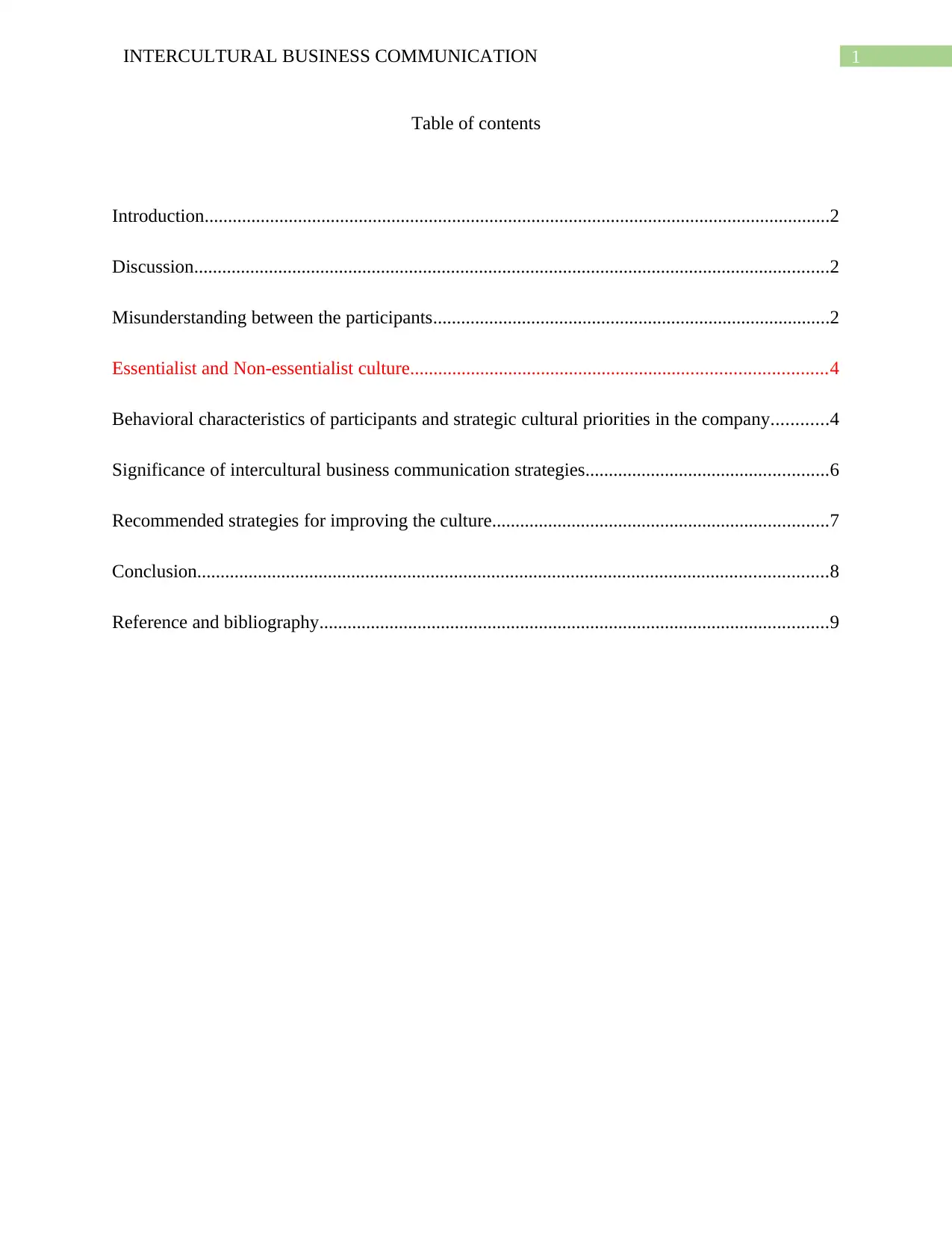
1INTERCULTURAL BUSINESS COMMUNICATION
Table of contents
Introduction......................................................................................................................................2
Discussion........................................................................................................................................2
Misunderstanding between the participants.....................................................................................2
Essentialist and Non-essentialist culture.........................................................................................4
Behavioral characteristics of participants and strategic cultural priorities in the company............4
Significance of intercultural business communication strategies....................................................6
Recommended strategies for improving the culture........................................................................7
Conclusion.......................................................................................................................................8
Reference and bibliography.............................................................................................................9
Table of contents
Introduction......................................................................................................................................2
Discussion........................................................................................................................................2
Misunderstanding between the participants.....................................................................................2
Essentialist and Non-essentialist culture.........................................................................................4
Behavioral characteristics of participants and strategic cultural priorities in the company............4
Significance of intercultural business communication strategies....................................................6
Recommended strategies for improving the culture........................................................................7
Conclusion.......................................................................................................................................8
Reference and bibliography.............................................................................................................9
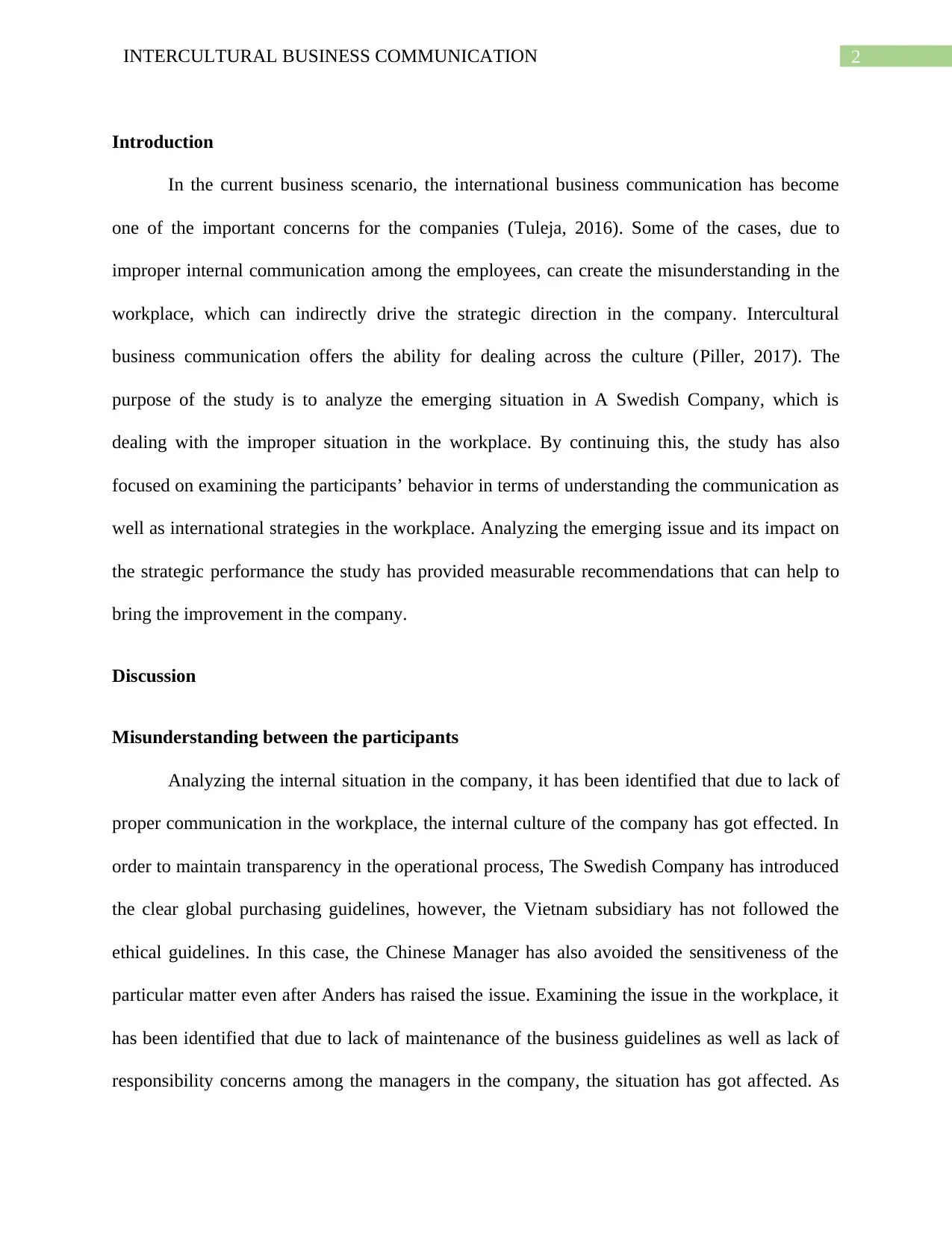
2INTERCULTURAL BUSINESS COMMUNICATION
Introduction
In the current business scenario, the international business communication has become
one of the important concerns for the companies (Tuleja, 2016). Some of the cases, due to
improper internal communication among the employees, can create the misunderstanding in the
workplace, which can indirectly drive the strategic direction in the company. Intercultural
business communication offers the ability for dealing across the culture (Piller, 2017). The
purpose of the study is to analyze the emerging situation in A Swedish Company, which is
dealing with the improper situation in the workplace. By continuing this, the study has also
focused on examining the participants’ behavior in terms of understanding the communication as
well as international strategies in the workplace. Analyzing the emerging issue and its impact on
the strategic performance the study has provided measurable recommendations that can help to
bring the improvement in the company.
Discussion
Misunderstanding between the participants
Analyzing the internal situation in the company, it has been identified that due to lack of
proper communication in the workplace, the internal culture of the company has got effected. In
order to maintain transparency in the operational process, The Swedish Company has introduced
the clear global purchasing guidelines, however, the Vietnam subsidiary has not followed the
ethical guidelines. In this case, the Chinese Manager has also avoided the sensitiveness of the
particular matter even after Anders has raised the issue. Examining the issue in the workplace, it
has been identified that due to lack of maintenance of the business guidelines as well as lack of
responsibility concerns among the managers in the company, the situation has got affected. As
Introduction
In the current business scenario, the international business communication has become
one of the important concerns for the companies (Tuleja, 2016). Some of the cases, due to
improper internal communication among the employees, can create the misunderstanding in the
workplace, which can indirectly drive the strategic direction in the company. Intercultural
business communication offers the ability for dealing across the culture (Piller, 2017). The
purpose of the study is to analyze the emerging situation in A Swedish Company, which is
dealing with the improper situation in the workplace. By continuing this, the study has also
focused on examining the participants’ behavior in terms of understanding the communication as
well as international strategies in the workplace. Analyzing the emerging issue and its impact on
the strategic performance the study has provided measurable recommendations that can help to
bring the improvement in the company.
Discussion
Misunderstanding between the participants
Analyzing the internal situation in the company, it has been identified that due to lack of
proper communication in the workplace, the internal culture of the company has got effected. In
order to maintain transparency in the operational process, The Swedish Company has introduced
the clear global purchasing guidelines, however, the Vietnam subsidiary has not followed the
ethical guidelines. In this case, the Chinese Manager has also avoided the sensitiveness of the
particular matter even after Anders has raised the issue. Examining the issue in the workplace, it
has been identified that due to lack of maintenance of the business guidelines as well as lack of
responsibility concerns among the managers in the company, the situation has got affected. As
⊘ This is a preview!⊘
Do you want full access?
Subscribe today to unlock all pages.

Trusted by 1+ million students worldwide
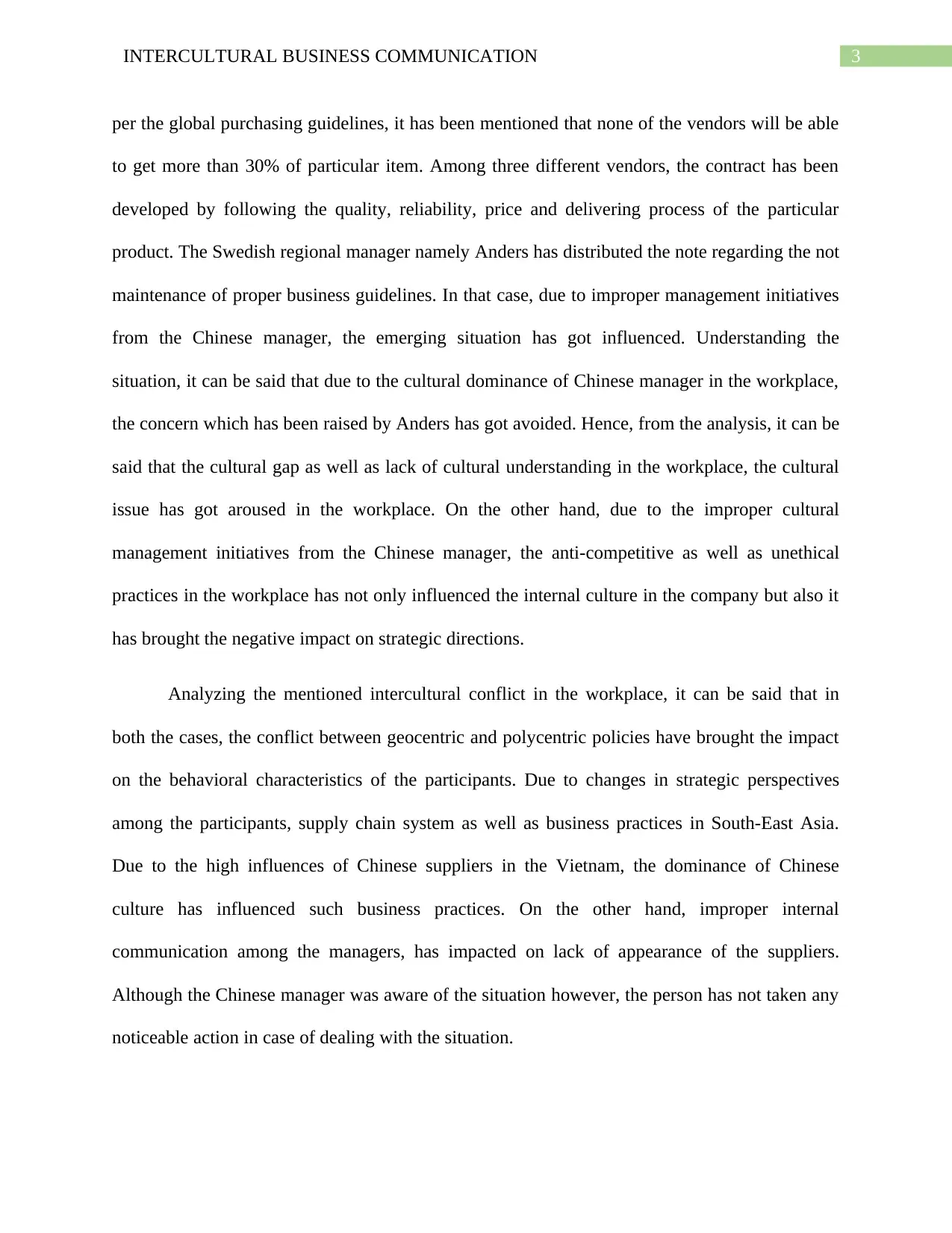
3INTERCULTURAL BUSINESS COMMUNICATION
per the global purchasing guidelines, it has been mentioned that none of the vendors will be able
to get more than 30% of particular item. Among three different vendors, the contract has been
developed by following the quality, reliability, price and delivering process of the particular
product. The Swedish regional manager namely Anders has distributed the note regarding the not
maintenance of proper business guidelines. In that case, due to improper management initiatives
from the Chinese manager, the emerging situation has got influenced. Understanding the
situation, it can be said that due to the cultural dominance of Chinese manager in the workplace,
the concern which has been raised by Anders has got avoided. Hence, from the analysis, it can be
said that the cultural gap as well as lack of cultural understanding in the workplace, the cultural
issue has got aroused in the workplace. On the other hand, due to the improper cultural
management initiatives from the Chinese manager, the anti-competitive as well as unethical
practices in the workplace has not only influenced the internal culture in the company but also it
has brought the negative impact on strategic directions.
Analyzing the mentioned intercultural conflict in the workplace, it can be said that in
both the cases, the conflict between geocentric and polycentric policies have brought the impact
on the behavioral characteristics of the participants. Due to changes in strategic perspectives
among the participants, supply chain system as well as business practices in South-East Asia.
Due to the high influences of Chinese suppliers in the Vietnam, the dominance of Chinese
culture has influenced such business practices. On the other hand, improper internal
communication among the managers, has impacted on lack of appearance of the suppliers.
Although the Chinese manager was aware of the situation however, the person has not taken any
noticeable action in case of dealing with the situation.
per the global purchasing guidelines, it has been mentioned that none of the vendors will be able
to get more than 30% of particular item. Among three different vendors, the contract has been
developed by following the quality, reliability, price and delivering process of the particular
product. The Swedish regional manager namely Anders has distributed the note regarding the not
maintenance of proper business guidelines. In that case, due to improper management initiatives
from the Chinese manager, the emerging situation has got influenced. Understanding the
situation, it can be said that due to the cultural dominance of Chinese manager in the workplace,
the concern which has been raised by Anders has got avoided. Hence, from the analysis, it can be
said that the cultural gap as well as lack of cultural understanding in the workplace, the cultural
issue has got aroused in the workplace. On the other hand, due to the improper cultural
management initiatives from the Chinese manager, the anti-competitive as well as unethical
practices in the workplace has not only influenced the internal culture in the company but also it
has brought the negative impact on strategic directions.
Analyzing the mentioned intercultural conflict in the workplace, it can be said that in
both the cases, the conflict between geocentric and polycentric policies have brought the impact
on the behavioral characteristics of the participants. Due to changes in strategic perspectives
among the participants, supply chain system as well as business practices in South-East Asia.
Due to the high influences of Chinese suppliers in the Vietnam, the dominance of Chinese
culture has influenced such business practices. On the other hand, improper internal
communication among the managers, has impacted on lack of appearance of the suppliers.
Although the Chinese manager was aware of the situation however, the person has not taken any
noticeable action in case of dealing with the situation.
Paraphrase This Document
Need a fresh take? Get an instant paraphrase of this document with our AI Paraphraser
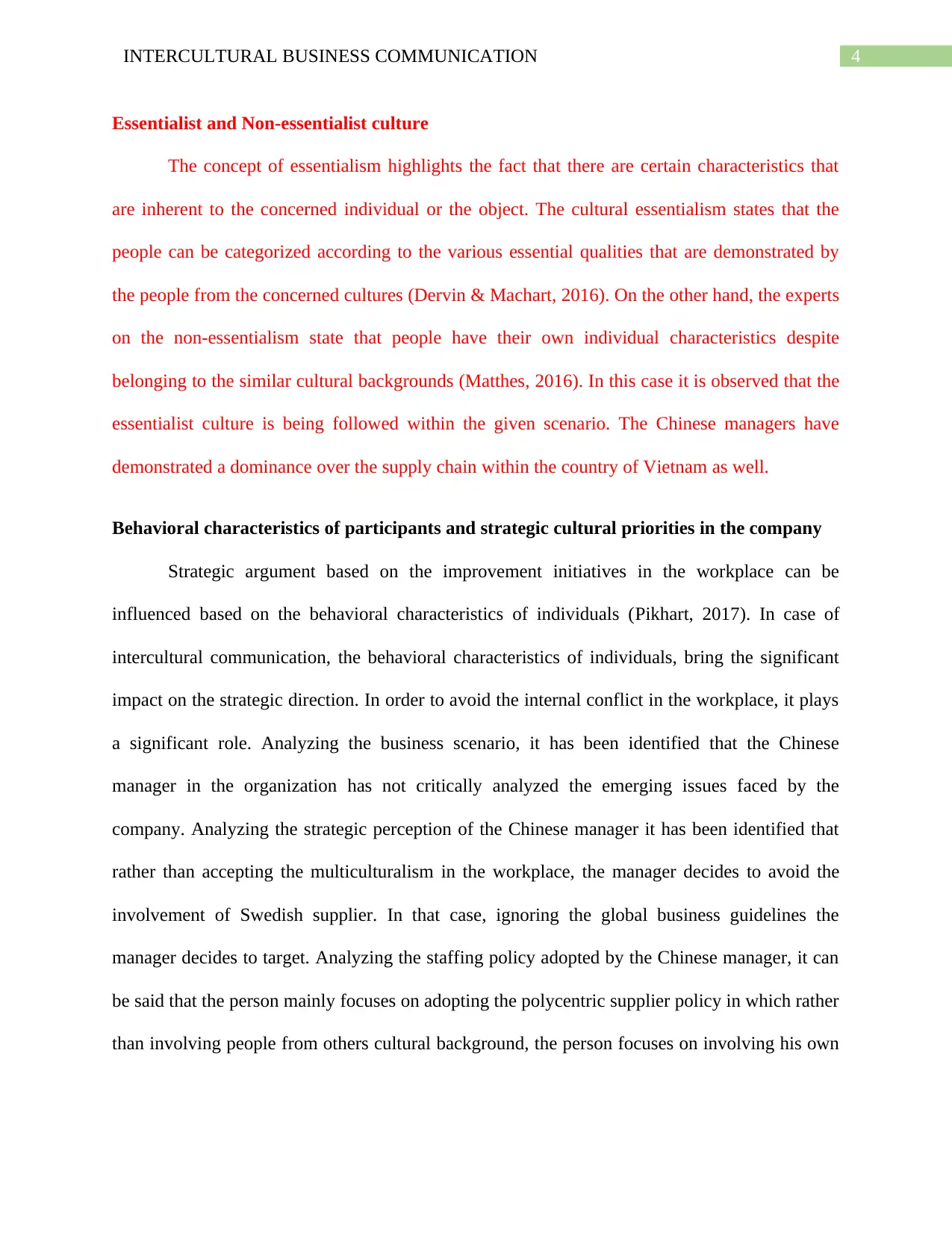
4INTERCULTURAL BUSINESS COMMUNICATION
Essentialist and Non-essentialist culture
The concept of essentialism highlights the fact that there are certain characteristics that
are inherent to the concerned individual or the object. The cultural essentialism states that the
people can be categorized according to the various essential qualities that are demonstrated by
the people from the concerned cultures (Dervin & Machart, 2016). On the other hand, the experts
on the non-essentialism state that people have their own individual characteristics despite
belonging to the similar cultural backgrounds (Matthes, 2016). In this case it is observed that the
essentialist culture is being followed within the given scenario. The Chinese managers have
demonstrated a dominance over the supply chain within the country of Vietnam as well.
Behavioral characteristics of participants and strategic cultural priorities in the company
Strategic argument based on the improvement initiatives in the workplace can be
influenced based on the behavioral characteristics of individuals (Pikhart, 2017). In case of
intercultural communication, the behavioral characteristics of individuals, bring the significant
impact on the strategic direction. In order to avoid the internal conflict in the workplace, it plays
a significant role. Analyzing the business scenario, it has been identified that the Chinese
manager in the organization has not critically analyzed the emerging issues faced by the
company. Analyzing the strategic perception of the Chinese manager it has been identified that
rather than accepting the multiculturalism in the workplace, the manager decides to avoid the
involvement of Swedish supplier. In that case, ignoring the global business guidelines the
manager decides to target. Analyzing the staffing policy adopted by the Chinese manager, it can
be said that the person mainly focuses on adopting the polycentric supplier policy in which rather
than involving people from others cultural background, the person focuses on involving his own
Essentialist and Non-essentialist culture
The concept of essentialism highlights the fact that there are certain characteristics that
are inherent to the concerned individual or the object. The cultural essentialism states that the
people can be categorized according to the various essential qualities that are demonstrated by
the people from the concerned cultures (Dervin & Machart, 2016). On the other hand, the experts
on the non-essentialism state that people have their own individual characteristics despite
belonging to the similar cultural backgrounds (Matthes, 2016). In this case it is observed that the
essentialist culture is being followed within the given scenario. The Chinese managers have
demonstrated a dominance over the supply chain within the country of Vietnam as well.
Behavioral characteristics of participants and strategic cultural priorities in the company
Strategic argument based on the improvement initiatives in the workplace can be
influenced based on the behavioral characteristics of individuals (Pikhart, 2017). In case of
intercultural communication, the behavioral characteristics of individuals, bring the significant
impact on the strategic direction. In order to avoid the internal conflict in the workplace, it plays
a significant role. Analyzing the business scenario, it has been identified that the Chinese
manager in the organization has not critically analyzed the emerging issues faced by the
company. Analyzing the strategic perception of the Chinese manager it has been identified that
rather than accepting the multiculturalism in the workplace, the manager decides to avoid the
involvement of Swedish supplier. In that case, ignoring the global business guidelines the
manager decides to target. Analyzing the staffing policy adopted by the Chinese manager, it can
be said that the person mainly focuses on adopting the polycentric supplier policy in which rather
than involving people from others cultural background, the person focuses on involving his own
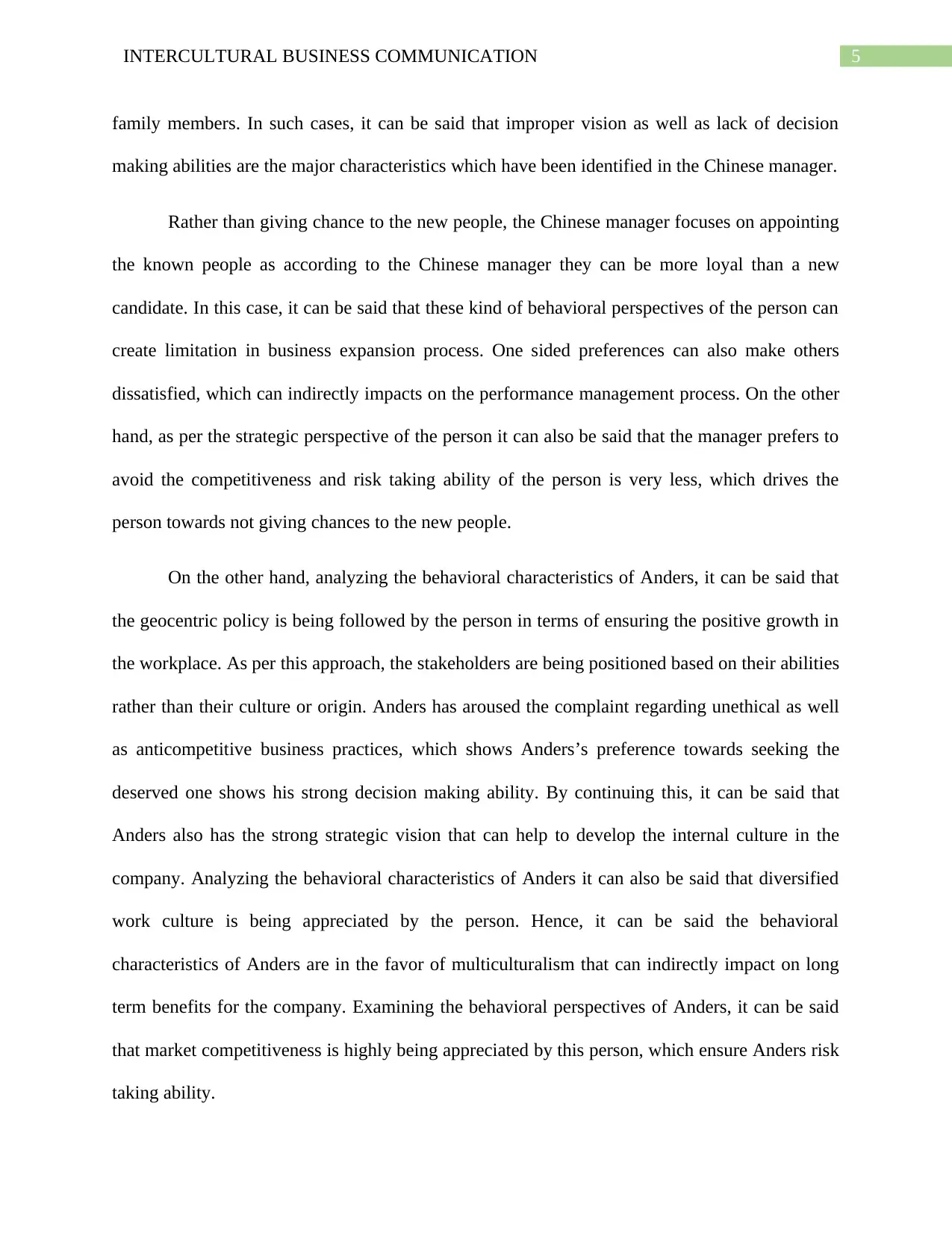
5INTERCULTURAL BUSINESS COMMUNICATION
family members. In such cases, it can be said that improper vision as well as lack of decision
making abilities are the major characteristics which have been identified in the Chinese manager.
Rather than giving chance to the new people, the Chinese manager focuses on appointing
the known people as according to the Chinese manager they can be more loyal than a new
candidate. In this case, it can be said that these kind of behavioral perspectives of the person can
create limitation in business expansion process. One sided preferences can also make others
dissatisfied, which can indirectly impacts on the performance management process. On the other
hand, as per the strategic perspective of the person it can also be said that the manager prefers to
avoid the competitiveness and risk taking ability of the person is very less, which drives the
person towards not giving chances to the new people.
On the other hand, analyzing the behavioral characteristics of Anders, it can be said that
the geocentric policy is being followed by the person in terms of ensuring the positive growth in
the workplace. As per this approach, the stakeholders are being positioned based on their abilities
rather than their culture or origin. Anders has aroused the complaint regarding unethical as well
as anticompetitive business practices, which shows Anders’s preference towards seeking the
deserved one shows his strong decision making ability. By continuing this, it can be said that
Anders also has the strong strategic vision that can help to develop the internal culture in the
company. Analyzing the behavioral characteristics of Anders it can also be said that diversified
work culture is being appreciated by the person. Hence, it can be said the behavioral
characteristics of Anders are in the favor of multiculturalism that can indirectly impact on long
term benefits for the company. Examining the behavioral perspectives of Anders, it can be said
that market competitiveness is highly being appreciated by this person, which ensure Anders risk
taking ability.
family members. In such cases, it can be said that improper vision as well as lack of decision
making abilities are the major characteristics which have been identified in the Chinese manager.
Rather than giving chance to the new people, the Chinese manager focuses on appointing
the known people as according to the Chinese manager they can be more loyal than a new
candidate. In this case, it can be said that these kind of behavioral perspectives of the person can
create limitation in business expansion process. One sided preferences can also make others
dissatisfied, which can indirectly impacts on the performance management process. On the other
hand, as per the strategic perspective of the person it can also be said that the manager prefers to
avoid the competitiveness and risk taking ability of the person is very less, which drives the
person towards not giving chances to the new people.
On the other hand, analyzing the behavioral characteristics of Anders, it can be said that
the geocentric policy is being followed by the person in terms of ensuring the positive growth in
the workplace. As per this approach, the stakeholders are being positioned based on their abilities
rather than their culture or origin. Anders has aroused the complaint regarding unethical as well
as anticompetitive business practices, which shows Anders’s preference towards seeking the
deserved one shows his strong decision making ability. By continuing this, it can be said that
Anders also has the strong strategic vision that can help to develop the internal culture in the
company. Analyzing the behavioral characteristics of Anders it can also be said that diversified
work culture is being appreciated by the person. Hence, it can be said the behavioral
characteristics of Anders are in the favor of multiculturalism that can indirectly impact on long
term benefits for the company. Examining the behavioral perspectives of Anders, it can be said
that market competitiveness is highly being appreciated by this person, which ensure Anders risk
taking ability.
⊘ This is a preview!⊘
Do you want full access?
Subscribe today to unlock all pages.

Trusted by 1+ million students worldwide
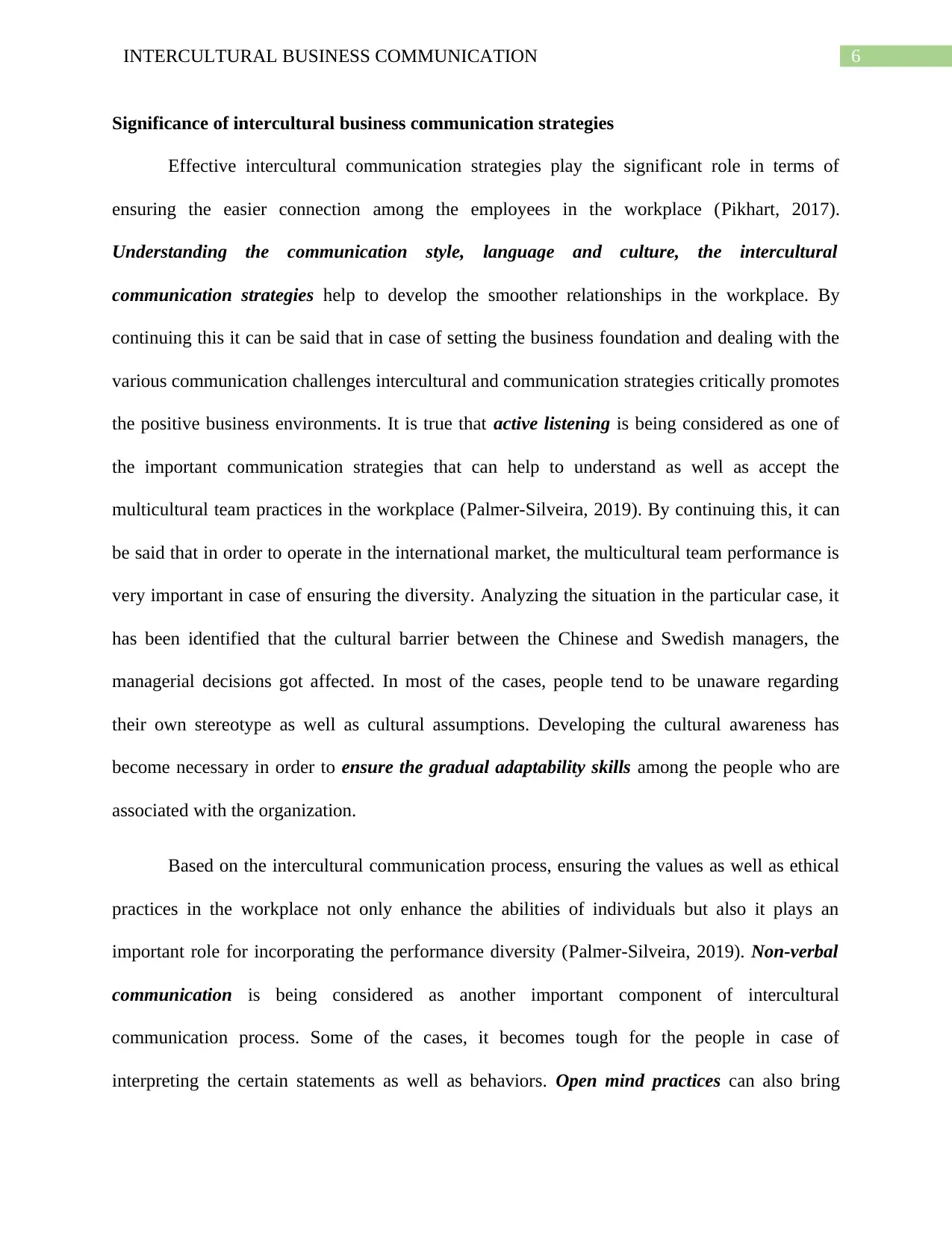
6INTERCULTURAL BUSINESS COMMUNICATION
Significance of intercultural business communication strategies
Effective intercultural communication strategies play the significant role in terms of
ensuring the easier connection among the employees in the workplace (Pikhart, 2017).
Understanding the communication style, language and culture, the intercultural
communication strategies help to develop the smoother relationships in the workplace. By
continuing this it can be said that in case of setting the business foundation and dealing with the
various communication challenges intercultural and communication strategies critically promotes
the positive business environments. It is true that active listening is being considered as one of
the important communication strategies that can help to understand as well as accept the
multicultural team practices in the workplace (Palmer-Silveira, 2019). By continuing this, it can
be said that in order to operate in the international market, the multicultural team performance is
very important in case of ensuring the diversity. Analyzing the situation in the particular case, it
has been identified that the cultural barrier between the Chinese and Swedish managers, the
managerial decisions got affected. In most of the cases, people tend to be unaware regarding
their own stereotype as well as cultural assumptions. Developing the cultural awareness has
become necessary in order to ensure the gradual adaptability skills among the people who are
associated with the organization.
Based on the intercultural communication process, ensuring the values as well as ethical
practices in the workplace not only enhance the abilities of individuals but also it plays an
important role for incorporating the performance diversity (Palmer-Silveira, 2019). Non-verbal
communication is being considered as another important component of intercultural
communication process. Some of the cases, it becomes tough for the people in case of
interpreting the certain statements as well as behaviors. Open mind practices can also bring
Significance of intercultural business communication strategies
Effective intercultural communication strategies play the significant role in terms of
ensuring the easier connection among the employees in the workplace (Pikhart, 2017).
Understanding the communication style, language and culture, the intercultural
communication strategies help to develop the smoother relationships in the workplace. By
continuing this it can be said that in case of setting the business foundation and dealing with the
various communication challenges intercultural and communication strategies critically promotes
the positive business environments. It is true that active listening is being considered as one of
the important communication strategies that can help to understand as well as accept the
multicultural team practices in the workplace (Palmer-Silveira, 2019). By continuing this, it can
be said that in order to operate in the international market, the multicultural team performance is
very important in case of ensuring the diversity. Analyzing the situation in the particular case, it
has been identified that the cultural barrier between the Chinese and Swedish managers, the
managerial decisions got affected. In most of the cases, people tend to be unaware regarding
their own stereotype as well as cultural assumptions. Developing the cultural awareness has
become necessary in order to ensure the gradual adaptability skills among the people who are
associated with the organization.
Based on the intercultural communication process, ensuring the values as well as ethical
practices in the workplace not only enhance the abilities of individuals but also it plays an
important role for incorporating the performance diversity (Palmer-Silveira, 2019). Non-verbal
communication is being considered as another important component of intercultural
communication process. Some of the cases, it becomes tough for the people in case of
interpreting the certain statements as well as behaviors. Open mind practices can also bring
Paraphrase This Document
Need a fresh take? Get an instant paraphrase of this document with our AI Paraphraser
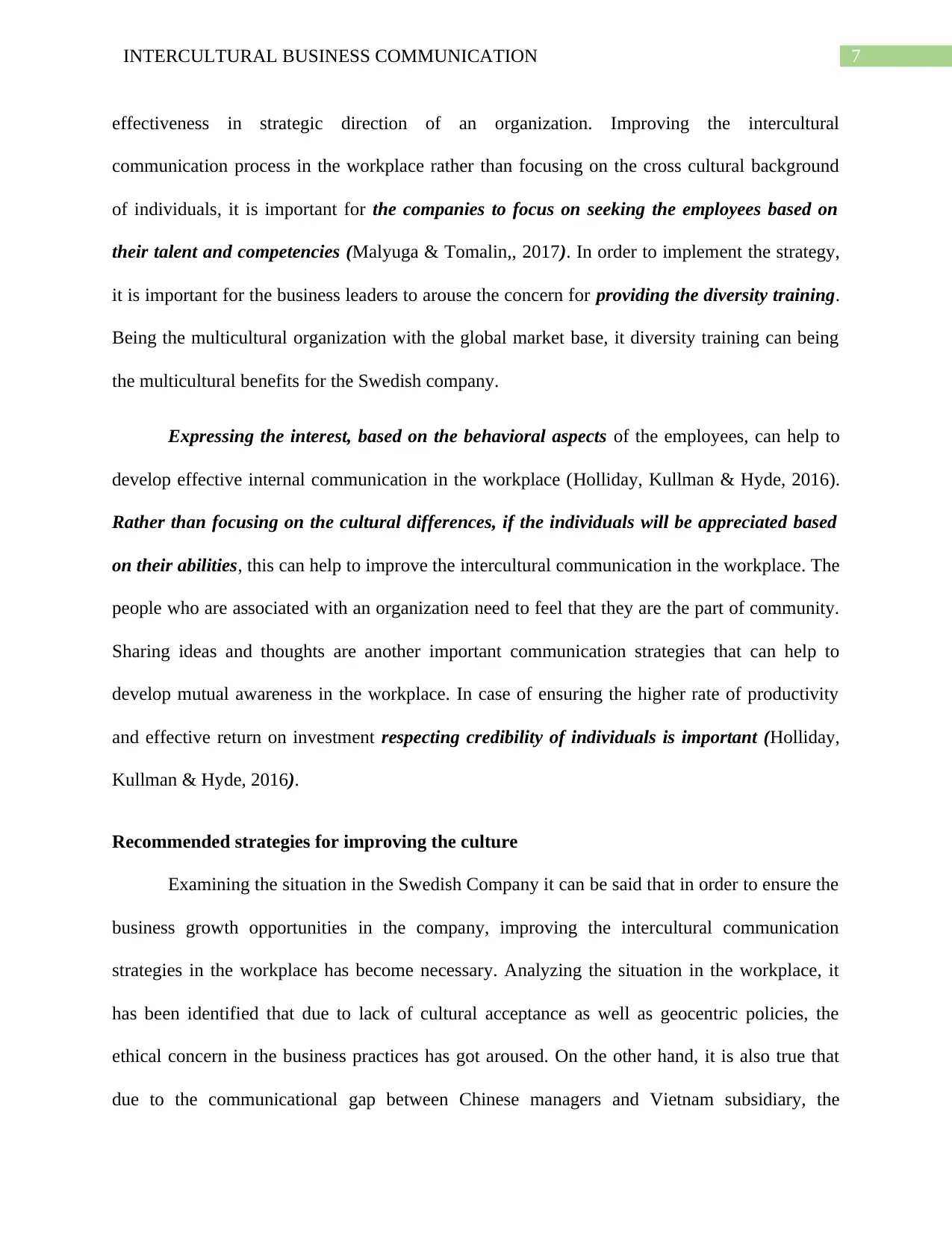
7INTERCULTURAL BUSINESS COMMUNICATION
effectiveness in strategic direction of an organization. Improving the intercultural
communication process in the workplace rather than focusing on the cross cultural background
of individuals, it is important for the companies to focus on seeking the employees based on
their talent and competencies (Malyuga & Tomalin,, 2017). In order to implement the strategy,
it is important for the business leaders to arouse the concern for providing the diversity training.
Being the multicultural organization with the global market base, it diversity training can being
the multicultural benefits for the Swedish company.
Expressing the interest, based on the behavioral aspects of the employees, can help to
develop effective internal communication in the workplace (Holliday, Kullman & Hyde, 2016).
Rather than focusing on the cultural differences, if the individuals will be appreciated based
on their abilities, this can help to improve the intercultural communication in the workplace. The
people who are associated with an organization need to feel that they are the part of community.
Sharing ideas and thoughts are another important communication strategies that can help to
develop mutual awareness in the workplace. In case of ensuring the higher rate of productivity
and effective return on investment respecting credibility of individuals is important (Holliday,
Kullman & Hyde, 2016).
Recommended strategies for improving the culture
Examining the situation in the Swedish Company it can be said that in order to ensure the
business growth opportunities in the company, improving the intercultural communication
strategies in the workplace has become necessary. Analyzing the situation in the workplace, it
has been identified that due to lack of cultural acceptance as well as geocentric policies, the
ethical concern in the business practices has got aroused. On the other hand, it is also true that
due to the communicational gap between Chinese managers and Vietnam subsidiary, the
effectiveness in strategic direction of an organization. Improving the intercultural
communication process in the workplace rather than focusing on the cross cultural background
of individuals, it is important for the companies to focus on seeking the employees based on
their talent and competencies (Malyuga & Tomalin,, 2017). In order to implement the strategy,
it is important for the business leaders to arouse the concern for providing the diversity training.
Being the multicultural organization with the global market base, it diversity training can being
the multicultural benefits for the Swedish company.
Expressing the interest, based on the behavioral aspects of the employees, can help to
develop effective internal communication in the workplace (Holliday, Kullman & Hyde, 2016).
Rather than focusing on the cultural differences, if the individuals will be appreciated based
on their abilities, this can help to improve the intercultural communication in the workplace. The
people who are associated with an organization need to feel that they are the part of community.
Sharing ideas and thoughts are another important communication strategies that can help to
develop mutual awareness in the workplace. In case of ensuring the higher rate of productivity
and effective return on investment respecting credibility of individuals is important (Holliday,
Kullman & Hyde, 2016).
Recommended strategies for improving the culture
Examining the situation in the Swedish Company it can be said that in order to ensure the
business growth opportunities in the company, improving the intercultural communication
strategies in the workplace has become necessary. Analyzing the situation in the workplace, it
has been identified that due to lack of cultural acceptance as well as geocentric policies, the
ethical concern in the business practices has got aroused. On the other hand, it is also true that
due to the communicational gap between Chinese managers and Vietnam subsidiary, the
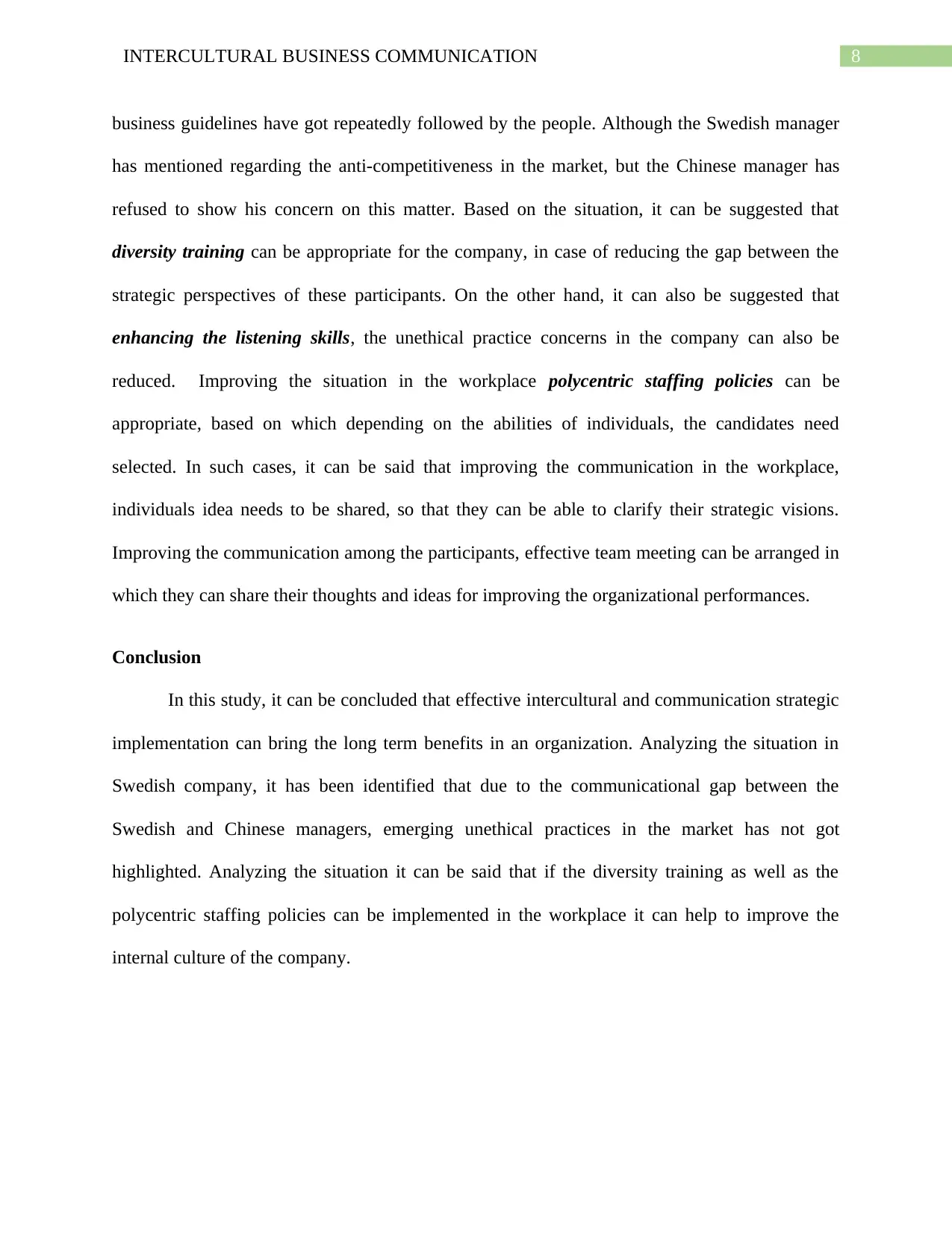
8INTERCULTURAL BUSINESS COMMUNICATION
business guidelines have got repeatedly followed by the people. Although the Swedish manager
has mentioned regarding the anti-competitiveness in the market, but the Chinese manager has
refused to show his concern on this matter. Based on the situation, it can be suggested that
diversity training can be appropriate for the company, in case of reducing the gap between the
strategic perspectives of these participants. On the other hand, it can also be suggested that
enhancing the listening skills, the unethical practice concerns in the company can also be
reduced. Improving the situation in the workplace polycentric staffing policies can be
appropriate, based on which depending on the abilities of individuals, the candidates need
selected. In such cases, it can be said that improving the communication in the workplace,
individuals idea needs to be shared, so that they can be able to clarify their strategic visions.
Improving the communication among the participants, effective team meeting can be arranged in
which they can share their thoughts and ideas for improving the organizational performances.
Conclusion
In this study, it can be concluded that effective intercultural and communication strategic
implementation can bring the long term benefits in an organization. Analyzing the situation in
Swedish company, it has been identified that due to the communicational gap between the
Swedish and Chinese managers, emerging unethical practices in the market has not got
highlighted. Analyzing the situation it can be said that if the diversity training as well as the
polycentric staffing policies can be implemented in the workplace it can help to improve the
internal culture of the company.
business guidelines have got repeatedly followed by the people. Although the Swedish manager
has mentioned regarding the anti-competitiveness in the market, but the Chinese manager has
refused to show his concern on this matter. Based on the situation, it can be suggested that
diversity training can be appropriate for the company, in case of reducing the gap between the
strategic perspectives of these participants. On the other hand, it can also be suggested that
enhancing the listening skills, the unethical practice concerns in the company can also be
reduced. Improving the situation in the workplace polycentric staffing policies can be
appropriate, based on which depending on the abilities of individuals, the candidates need
selected. In such cases, it can be said that improving the communication in the workplace,
individuals idea needs to be shared, so that they can be able to clarify their strategic visions.
Improving the communication among the participants, effective team meeting can be arranged in
which they can share their thoughts and ideas for improving the organizational performances.
Conclusion
In this study, it can be concluded that effective intercultural and communication strategic
implementation can bring the long term benefits in an organization. Analyzing the situation in
Swedish company, it has been identified that due to the communicational gap between the
Swedish and Chinese managers, emerging unethical practices in the market has not got
highlighted. Analyzing the situation it can be said that if the diversity training as well as the
polycentric staffing policies can be implemented in the workplace it can help to improve the
internal culture of the company.
⊘ This is a preview!⊘
Do you want full access?
Subscribe today to unlock all pages.

Trusted by 1+ million students worldwide

9INTERCULTURAL BUSINESS COMMUNICATION
Reference and bibliography
Dervin, F., & Machart, R. (Eds.). (2016). Cultural essentialism in intercultural relations.
Springer.
Holliday, A., Kullman, J., & Hyde, M. (2016). Intercultural communication: An advanced
resource book for students. Routledge.
Lockwood, J. (2015). Virtual team management: what is causing communication
breakdown?. Language and intercultural communication, 15(1), 125-140.
Malyuga, E. N., & Tomalin, B. (2017). Communicative strategies and tactics of speech
manipulation in intercultural business discourse. Training language and culture, 1(1), 28-
47.
Matthes, E. H. (2016). Cultural appropriation without cultural essentialism?. Social Theory and
Practice, 42(2), 343-366.
Palmer-Silveira, J. (2019). Introducing Business Presentations to Non-Native Speakers of
English: Communication Strategies and Intercultural Awareness.
Pikhart, M. (2017). Managerial communication and its changes in the global intercultural
business world. In SHS Web of Conferences (Vol. 37, p. 01013). EDP Sciences.
Piller, I. (2017). Intercultural communication: A critical introduction. Edinburgh University
Press.
Tuleja, E. (2016). Intercultural Communication for Global Business: How leaders communicate
for success. Routledge.
Reference and bibliography
Dervin, F., & Machart, R. (Eds.). (2016). Cultural essentialism in intercultural relations.
Springer.
Holliday, A., Kullman, J., & Hyde, M. (2016). Intercultural communication: An advanced
resource book for students. Routledge.
Lockwood, J. (2015). Virtual team management: what is causing communication
breakdown?. Language and intercultural communication, 15(1), 125-140.
Malyuga, E. N., & Tomalin, B. (2017). Communicative strategies and tactics of speech
manipulation in intercultural business discourse. Training language and culture, 1(1), 28-
47.
Matthes, E. H. (2016). Cultural appropriation without cultural essentialism?. Social Theory and
Practice, 42(2), 343-366.
Palmer-Silveira, J. (2019). Introducing Business Presentations to Non-Native Speakers of
English: Communication Strategies and Intercultural Awareness.
Pikhart, M. (2017). Managerial communication and its changes in the global intercultural
business world. In SHS Web of Conferences (Vol. 37, p. 01013). EDP Sciences.
Piller, I. (2017). Intercultural communication: A critical introduction. Edinburgh University
Press.
Tuleja, E. (2016). Intercultural Communication for Global Business: How leaders communicate
for success. Routledge.
Paraphrase This Document
Need a fresh take? Get an instant paraphrase of this document with our AI Paraphraser
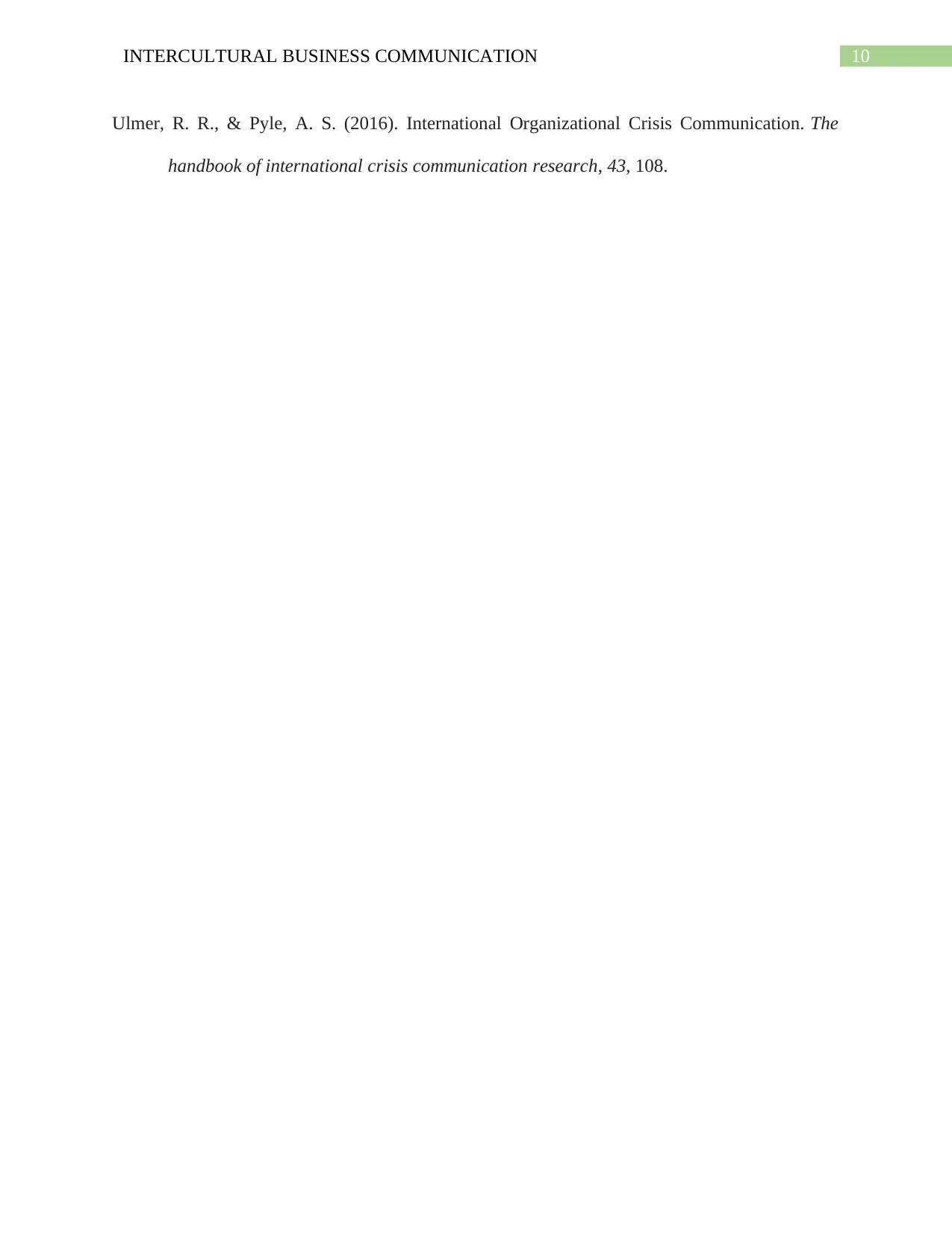
10INTERCULTURAL BUSINESS COMMUNICATION
Ulmer, R. R., & Pyle, A. S. (2016). International Organizational Crisis Communication. The
handbook of international crisis communication research, 43, 108.
Ulmer, R. R., & Pyle, A. S. (2016). International Organizational Crisis Communication. The
handbook of international crisis communication research, 43, 108.
1 out of 11
Related Documents
Your All-in-One AI-Powered Toolkit for Academic Success.
+13062052269
info@desklib.com
Available 24*7 on WhatsApp / Email
![[object Object]](/_next/static/media/star-bottom.7253800d.svg)
Unlock your academic potential
Copyright © 2020–2025 A2Z Services. All Rights Reserved. Developed and managed by ZUCOL.
![Intercultural Business Communication Analysis Report - [Course Name]](/_next/image/?url=https%3A%2F%2Fdesklib.com%2Fmedia%2Fimages%2Fmh%2F6bdbf48c819449968e15eda2e27fc2fb.jpg&w=256&q=75)



